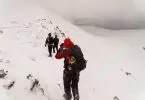A camping first aid kit is considered to be a staple for every outdoors person out there. When you’re active, vibrant or seemingly flamboyant in your outdoor or indoor activities, for that matter, there may be cases where the “whoops” or the “oh crap” just happens, leaving you or someone else with anything from a gaping wound to a minor scrape.
See also: Snake Bite First Aid: How To Manage An Unpleasant Encounter
Whatever the case may be, for outdoor enthusiasts, a camping first aid kit absolutely NEEDS to be within arm’s reach. First aid kits were built to treat and to prevent, and when used correctly, the contents can fulfill their purpose.
With that being said, it’s extremely important that anyone who will be using the contents of the kit, learn the uses of all the items that it contains. This is what makes using the kit effective. But just what is the first aid kit and what does it contain? Let’s find out shall we?
What’s in the Box?
A traditional first aid kit is basically a collection of supplies and equipment, used to give medical treatment or care, and it can be packed together either by an individual or a group or team of people, or it can be purchased as a complete set.
There are two basic types of First Aid Kits
These make up the back-bone or skeletal structure of the first aid medical kit.
- Commercial – these are available via normal retail routes and are usually intended for treatment or care of specifically minor injuries. The typical contents of these commercial kits include adhesive bandages, regular strength pain meds, gauze and low grade disinfectant.
- Specialized – these are available for various regions, vehicles or activities, which may focus on specific risks or concerns related to that activity which may carry that risk. For example, first aid kits sold through marine supply stores (like the one shown below), for use in watercraft may contain seasickness remedies.
First Aid is all about the ABCs of treatment and care. And just what do we mean by that? All kits no matter what their content, must boil down to three key areas of concern. They are;
A – Airway
B – Breathing
C – Circulation
Most first aid kits today may also contain a suitable infection barrier for performing artificial respiration. Some examples of this includes the pocket mask and the face shield. Other more advanced kits may include a bag valve mask, manual aspirator or suction unit, oropharyngeal airway, nasopharyngeal airway, stethoscope and a blood pressure cuff.
Now for the regular outdoor enthusiast, it’s not uncommon to see a first aid kit packed among the many items which make that nature trip oh so exciting!
Now let’s be real here, so far, we’ve talked about the importance of the kit and how it can come in handy and all that, but when you’re talking about hiking, backpacking, mountaineering, fishing, camping, you’re not looking to lug an entire case on back in addition to your tools and essentials right?
So how can this possibly work? How can you keep things light, which is really important to you, and also ensure that you have all the necessaries, which is also really important? So this is where we get down to practical and functional business. The basic criteria that a first aid kit needs to meet for outdoor purposes are;
- Quality and usefulness of the contents
- The durability and design of the bag or case
- Versatility
- Weight and size of the entire kit
And of course it doesn’t hurt to consider affordability either, which of course, is a real nice bonus.
When it comes to selecting the right first aid kit for your camping needs, there are many out there to choose from. You have the option of getting ready-made kits of a variety of sizes to suit a variety of activities, although, there is no rule which says that you can’t put together your own kit.
Only you would know what your trip would be like and what type of dangers or mishaps you may encounter, (although these things can be quite unpredictable) so assembling your own kit is okay too.
Bringing it Closer to Home
For the outdoor enthusiast, there are two types of kits which when assembled, would reflect, the intended activities and the length of the trip; Day Use and Overnight Use.
Day Use First Aid Kits
These type of kits are meant for short trips and a few hour long hikes and excursions. Based on this short-term activity, the contents of this kit would address incidents such as minor scrapes and bruises that you may encounter on the trail.
In keeping with the activity, the content of this type of kit would look like;
Bandage Materials
- Bandages – An assortment of bandages of various sizes
- Gauze – These are used as dressings which come in 4 x 4 and 3 x 3 inch sizes.
- Non-stick Sterile Pads – Which are applied directly to the injury and provides a seal of protection from the elements which would have otherwise worsen the injury or infect it.
Handling Protection
- Medical or Surgical Gloves – It’s important to note that latex should be avoided as much as possible and it’s more advisable to opt for nitrile gloves.
Blisters & Burn Treatment
- Blister Relief such as moleskin or glacier gel
CPR
- A breathing barrier – This is used to protect the rescuer during CPR
Miscellaneous
- Fine Point Tweezers – For splinters and other pointy objects
- Safety Pins – to secure bandages or other dressings
- Pain Relief Medication – Which is used to help reduce swelling and ease pain
- Antihistamines – Used to treat allergic reactions from plants and animals
- Insect Sting or Bites Relief – Treatment for stings and bites from animals
- Antiseptic Towelettes – Used for cleaning and disinfecting injuries
- Antibacterial Ointment – This is used for protection against infection if you get burns, cuts, scrapes and other injuries
- Butterfly Bandages – This is used to help injuries close
- Waterproof Medical Adhesive Tape – Used to keep bandages in place since you will be moving around. We advise that you use those which are waterproof to ensure that injuries which should not come into contact with water, are kept dry.
See our DIY homemade first aid kits to customize it for your specific needs.
Overnight Use First Aid Kits
These types of kits are meant for trips that take you away for more than a day, away from civilization which will leave you needing to be very self-sufficient.
Because the length of this trip may be a few days or weeks, the content would be different than the Day Use kit. The content of this kit would look like;
Bandage Materials
- Rolled Gauze – Used to wrap limbs after injury
- Stretch to conform Rolled Bandages – such as the Conform Stretch Bandage
- Liquid Bandages – These offer an alternative to keeping injuries from getting infected, which offers a breathable, flexible and waterproof barrier
- Oval Eye Pads
Handling Protection
- Medical or Surgical Gloves – It’s important to note that latex should be avoided as much as possible and it’s more advisable to opt for nitrile gloves.
Blisters & Burn Treatment
- Hemostatic Gauze – This aids in blood clotting
- A Medical Waste Bag & Gloves
- Aloe Vera Gel – Used for sun exposure relief
- Hydrogel-based Pads – These offer a nice soothing and cooling relief for burns and can also be used to help drain unwanted liquid from injuries
Fracture & Sprains
- Elastic Wrap – For securing bandages and joints free from movement
- A Triangular Cravat Bandage
- Finger Splints
- A Sam Splint
- Athletic Tape
Miscellaneous
- An irrigation Syringe with Catheter for flushing injuries
- Steel Sewing Needle with Heavy Duty Thread
- A Pocket Knife or Multi-Tool
- Trauma Shears – Used to cut away clothing from an injured person
- A Single Edge Razor Blade
- Standard Oral Thermometer
- First-aid Cleansing Pads – With topical anesthetic to kill germs
- Cotton Balls and Cotton Tipped Swabs
- A small bottle of Sterile Saline – Used to flush out foreign particles
- Petroleum Jelly – In case of chaffing
Medications
- Aspirin – For cases of heart attacks. However they should never be given to children
- Antacid Tablets – To settle upset stomach
- Loperamide Tablets – Used in cases of diarrhea
- Throat Lozenges
- A small Roll of Duct Tape
- A Magnifying Glass
- A Small Mirror
Personal Hygiene
- Hand Sanitizer
- Lubricating Eye Drops
- Biodegradable Soap
- A Water Treatment System
- Anti-itch Eye Drops
- Sunscreen
- Lip Balm
- Insect Repellant
- Disposable Human Waste Bags
Durability and Design of the Case/Kit/Box/Bag
We are aware that this may not have been on your must check for list but the truth is, this factor is just as important as the contents of the kit itself. Reason for this, is that due to the type of trips and the length of trips you’d be taking, the material of the kit/bag/case/box is really important.
You want to be sure that the contents of the kit are protected at all times. Being weather resistant, is an added plus for a camping first aid kit.
Weight and Size
This part of the deciding factor is key as most camping enthusiasts want to and need to carry as much as they need but nothing that add unnecessary weight to their trip, and as much as the first aid kit is important, having a heavy kit would force you to lag behind and would deter you from enjoying the activity that you set out for.
The ideal camping first aid kit should weigh a minimum of at least 3 or 4 ounces and for the most, should weigh no more than 35 ounces.
Affordability
Finding the best kit for your budget is kind of tricky. When you have so much to look for and so many variations out there to considers including the purpose of the kit, deciding on which one is more cost effective is tricky.
As far as we are concerned, once that first aid kit serves its purpose, and does what it’s supposed to do, the price should be the furthest thing from your mind. But in reality, from what we’ve seen on the market, the REI Kits seems to get the nod of most customers with regards to content, versatility, durability and of course affordability.
Some Options
If the information we provided makes it easier to make your choice, then here are a few options to consider which can be found on Amazon. The top brands are from REI, Adventure Medical Kits, Lifeline Trail, Coleman, I Go, Oumers, ResQue, Total Resources International and many more.
Look For That Symbol
When looking for the ideal first aid kit, aside from looking at the contents, it’s important to analyze the outside as well. There is a symbol which adorns itself to the case/box/bag/kit which is easily identified with health care and first aid. Do read our article on how to select the best first aid kit for your needs.
A genuine product and first aid kit MUST carry one of either of these symbols. If they don’t, please don’t purchase it. There are four symbols which you may see. They are;
- The ISO first aid symbol
- The Alternate Version of the First Aid Symbol
- Symbol of the Red Cross
- Star of Life
- Stay Safe
In Closing
So no matter what the occasion or excursion or outdoor trip that you’re on, once you leave the comfort of your home, be sure to carry with you, the items that you need to not only keep your outing a safe one, but also and enjoyable one too.
We’ve provided you with several bits of information to decide on which first aid kit out there would be the best one for you for your camping needs. But once you’ve made your choice, the idea is to stay safe, not go looking for trouble! See our review of the top backpacking first aid kit to help you choose the right one.
Featured Image Source: https://unsplash.com/photos/MaKsx8JNbiI








